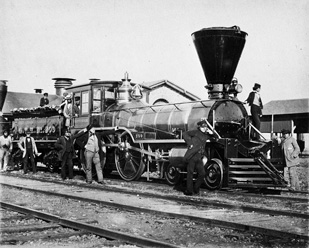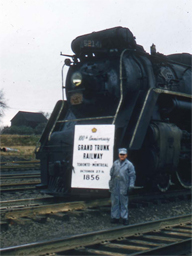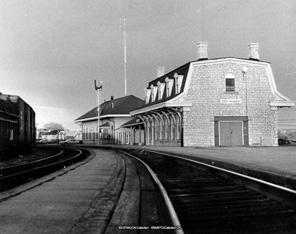A Century and a Half of Montreal-Toronto Trains
By Derek Boles, Toronto Railway Historical Association
October 27, 2006 is the 150th anniversary of passenger train service between Toronto and Montreal. The 333-mile corridor connecting Canada's two largest cities has always been the busiest intercity passenger train route in the country.

|
|
The first Grand Trunk locomotive built in Canada was the "Trevithick", built at
Point St. Charles shops in Montreal Library and Archives of Canada PA-041333 |
The Grand Trunk Railway of Canada was incorporated in 1852 to build the line and the construction contract was awarded to the British firm of Brassey, Peto & Betts. After four years of difficult and expensive construction, the Grand Trunk was open for business. On October 27, 1856, the inaugural train departed from Toronto at 7:00 a.m. and consisted of ten wooden cars hauled by two wood-burning steam locomotives. At a top speed of 30 mph, the train didn't arrive in Montreal until 9:00 p.m., fourteen hours later.
While the trip was long by today's standards, it represented a remarkable achievement in Canadian transportation. Prior to the railway, the fastest means of overland transport between the two cities was a grueling stagecoach journey that could take several days in bad weather.
The first Grand Trunk Toronto train station was located on the east side of the Don River as the railway had not yet entered the city proper. In 1857 that first depot was replaced by a station at Bay and Front Streets. Later that year, the railway introduced overnight trains with sleeping cars between Toronto and Montreal. In 1858, the Grand Trunk opened Toronto's first Union Station, located between York and Simcoe Streets.
The GTR enjoyed a monopoly on Toronto-Montreal train travel until 1884 when the rival Canadian Pacific Railway began a passenger service between the two cities. Although the Grand Trunk had the fastest and most direct route, the fierce competition between the two railways meant that the locomotives and passenger cars were continuously being upgraded and the level of onboard service was the finest anywhere in Canada. For many years, the most prestigious Grand Trunk corridor train was the International Limited that traversed a total of 840 miles between Montreal and Chicago.

|
|
The CNR celebrated the 100th anniversary of their
Montreal-Toronto line at Kingston in this October 27, 1956
photo C. Robert Craig Memorial Library |
By the early 1920's, the Grand Trunk was bankrupt and taken over by the newly formed Canadian National Railways. The CNR continued the intense competition with the Canadian Pacific Railway and passengers traveling between Toronto and Montreal enjoyed unparalleled levels of service. CN introduced luxurious new passenger cars and even set up Canada's first radio network, solely for the amusement of first class passengers. The railway introduced the first diesel hauled passenger train between the two cities in 1929, over a quarter century before diesels entirely replaced steam locomotives along this route. In 1930, passengers could choose from among 24 daily CN and CP passenger trains between Toronto and Montreal, twelve of which were overnight trains that departed within minutes of each other and offered full sleeping car service.
The Great Depression soon rendered such expensive competition wasteful and the two rival railways decided to collaborate on their Toronto-Montreal passenger trains in 1933. This "pool train" arrangement lasted over three decades and the railways went their own ways in 1965. Within months Canadian Pacific decided to abandon its Toronto-Montreal passenger train service, leaving the field to Canadian National.
Rather than rest on its laurels, CN continued to upgrade passenger service. The speedy new "Rapido" trains reduced the travel time between the two cities to less than five hours. In 1968, the railway introduced the revolutionary new Turbo train along this route. Despite mechanical difficulties, the Turbos ran until 1982 and established a Canadian land speed record of 140 mph in 1976.
By the 1970's even CN had given up on passengers and the government created VIA Rail, a new crown corporation that took over most of Canada's passenger trains in 1978. VIA has continued to upgrade service, introducing the LRC (Light, Rapid, Comfortable) train sets in 1981 and the Renaissance equipment in 2002. Today, over 50% of VIA's passengers pass through Toronto Union Station and the Toronto-Montreal corridor remains the busiest intercity passenger train route in Canada.
Passengers on that first October 27, 1856 train would only gape in astonishment at VIA's current fastest travel time between the two cities of four hours and sixteen minutes.
Heritage Railway Stations on the Montreal-Toronto Line
By Andrew Jeanes

|
|
The former GTR/CNR Kingston Outer Station in 1974 CN Collection, Canada Science and Technology Museum |
At the time of its construction, the Grand Trunk Railway erected handsome stations at all major communities through which it passed. A remarkably large number of these original stations have survived from the 1850s to the present day, largely retaining their original appearance. This includes the stations at Prescott, Kingston, Ernestown, Napanee, Belleville, Brighton and Port Hope. Of these survivors, only Napanee, Belleville and Port Hope retain passenger service. A new station was built in Kingston in 1974 when the line was relocated to straighten out a very tight curve. The station in Brighton is now a museum, while the station in Prescott--a National Historic Site of Canada along with Belleville--is soon to be taken over by the Grenville County Historical Society.